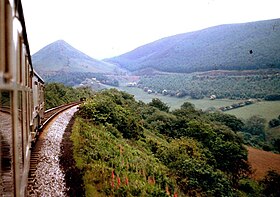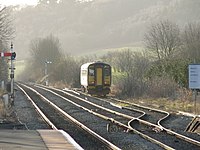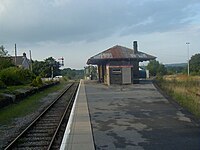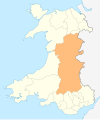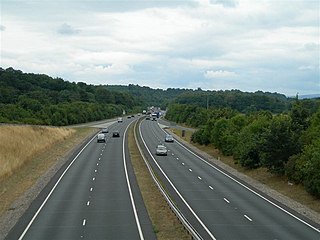
The A483, officially described as the Swansea to Manchester Trunk Road, although now ending in Chester, is a major road in the United Kingdom. It runs from Swansea in Wales to Chester in England via Llandovery, Llandrindod Wells, Oswestry and Wrexham, a distance of around 153 miles (246 km).

The West Wales lines are a group of railway lines from Swansea through Carmarthenshire to Pembrokeshire, West Wales. The main part runs from Swansea to Carmarthen and Whitland, where it becomes three branches to Fishguard, Milford Haven and Pembroke Dock.

Craven Arms railway station serves the town of Craven Arms in Shropshire, England. Until 1974 it was known as "Craven Arms and Stokesay", named after the nearby coaching inn and the historic settlement of Stokesay to the south. It is situated at the junction of the Welsh Marches Line and the Heart of Wales Line, 20 miles (32 km) south of Shrewsbury. All passenger trains calling at the station are operated by Transport for Wales, who also manage it.

Builth Road railway station is a station primarily serving the town of Builth Wells, in mid Wales. It is on the Heart of Wales Line. The station is over two miles northwest of Builth Wells via the A470, a busy trunk road.

Transport in Wales is heavily influenced by the country's geography. Wales is predominantly hilly or mountainous, and the main settlements lie on the coasts of north and south Wales, while mid Wales and west Wales are lightly populated. The main transport corridors are east–west routes, many continuing eastwards into England.

Llandrindod railway station, 51+3⁄4 miles (83.3 km) south-west of Shrewsbury, serves the town of Llandrindod Wells in Mid Wales. The single-track Heart of Wales Line is served by five Transport for Wales trains each way on Mondays to Saturdays, two each way on Sundays. The passing line for northbound and southbound trains is used daily. It is the busiest station on the line itself, despite the small number of trains. This causes overcrowding on some trains.

Bynea railway station serves the village of Bynea near Llanelli, Carmarthenshire, Wales. Bynea station is situated close to the Millennium Coastal Park and is a convenient stop for cyclists and hikers to the coastal area. It is also the last stop on the Heart of Wales route before it joins the West Wales Line at Llandeilo Junction, to the east of Llanelli.

Llangennech railway station is a railway station in the village of Llangennech. It lies on the Heart of Wales line with services operated by Transport for Wales running to and from Swansea and Shrewsbury.

Pontarddulais railway station serves the town of Pontarddulais and village of Hendy in Swansea, Wales. The station is located at street level not far from the town centre and the Loughor estuary. All trains serving the station are operated by Transport for Wales.

Llandeilo railway station serves the town of Llandeilo, Carmarthenshire. The station is 30+3⁄4 miles (49 km) north east of Swansea on the Heart of Wales Line.

Llangadog railway station serves the village of Llangadog near Llandeilo, Carmarthenshire. The station is on the Heart of Wales Line 36+1⁄2 miles (59 km) north east of Swansea. The station is located at street level at Station Road beside the River Brân. The Garn Goch Iron Age hill fort is about three miles away from this station.

Llanwrda railway station serves the village of Llanwrda near Llandovery, Carmarthenshire. Opened by the Vale of Towy Railway in 1858, the station is on the Heart of Wales Line 38+1⁄4 miles (61.6 km) north east of Swansea. The station is located below street level at the end of a lane opposite the A40 that leads to the centre of the village.

Llandovery railway station serves the market town of Llandovery, Carmarthenshire, Wales. The station is on the Heart of Wales Line 42 miles (68 km) north east of Swansea and is located at Tywi Avenue.

Sugar Loaf railway station is a railway station in Powys,Wales, and is part of the Heart of Wales Line. It is the most geographically remote station in Wales. The station is located one mile northeast of a small but prominent knoll known as Sugar Loaf, around which the A483 road loops.

Llanwrtyd railway station serves the town of Llanwrtyd Wells, Powys, Wales. The station is on the Heart of Wales Line 53+1⁄2 miles (86 km) north east of Swansea. The railway station is located at street level at Station Road near the town centre. All trains serving the station are operated by Transport for Wales.

Llangammarch railway station serves the village of Llangammarch Wells in Powys, Wales. Situated near the centre of the village, the station is on the Heart of Wales Line 56+3⁄4 miles (91.3 km) north east of Swansea.

Knighton railway station serves the border market town of Knighton in Powys, Wales, although the station itself is located in Shropshire, England. It lies 32+1⁄2 miles (52.3 km) south west of Shrewsbury on the Heart of Wales Line.
On 19 October 1987, a train on the Heart of Wales line derailed and fell into the River Towy due to the partial collapse of the Glanrhyd Bridge near Llandeilo, Carmarthenshire. Four people died as a result of the tragedy; the driver and three of the passengers drowned.
Llanfair-y-bryn is a community and Church in Wales parish in Carmarthenshire, Wales. Covering an area of some 95 km², it lies along and to the northwest and southeast of the A483 Swansea to Chester road immediately north of the town of Llandovery. The population of the community at the 2011 census was 624. The term also referred to a church located outside the parish.
